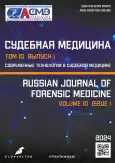人工智能和人体芯片植入在法医学鉴定中的应用:科学综述
- 作者: Sadykov M.B.1, Begaliyev Y.N.1, Bakhteev D.V.2, Kaziyeva A.N.3, Khussainov O.B.3
-
隶属关系:
- Academy of Law Enforcement Agencies Under the General Prosecutors Office of the Republic of Kazakhstan
- Ural State Law University named after V.F. Yakovlev
- Abai Kazakh National Pedagogical University
- 期: 卷 10, 编号 1 (2024)
- 页面: 88-98
- 栏目: 科学评论
- URL: https://bakhtiniada.ru/2411-8729/article/view/254430
- DOI: https://doi.org/10.17816/fm16093
- ID: 254430
如何引用文章
全文:
详细
本文介绍在法医学霸鉴定中应用人工智能和人体芯片植入的一些方面,包括伦理和法律问题的解决。该文章中分析了哈萨克斯坦共和国和外国科学家的研究。作者指出,人工智能系统在现阶段的科技发展中已在法医精神病学中得到了最大程度的应用。
总体而言,在已发现的不足之处的背景下,缺乏关于人工智能和人类芯片植入在法医学鉴定中的协同作用的出版物,也缺乏在这一领域应用人工智能和人类芯片植入的法律和伦理方面的研究。为此,作者进行了SWOT分析。分析表明了,这些技术在效率和准确性方面有许多优势和机会。
根据对文献数据的研究以及人工智能和人体芯片植入在法医学鉴定中的实际应用,作者确定了法律和伦理方面的问题。它们与人工智能和人体芯片植入的协同作用有关。这些方面可大致分为几个相互重叠的关键领域:数据隐私和安全、知情同意、所有权和控制权(这是法律方面)。伦理方面包括自主权的尊重、隐私和合乎道德的数据处理、无伤害、知情同意。
作者简介
Mukhtar B. Sadykov
Academy of Law Enforcement Agencies Under the General Prosecutors Office of the Republic of Kazakhstan
编辑信件的主要联系方式.
Email: mukhtar.sadykov@gmail.com
ORCID iD: 0000-0002-1705-0157
SPIN 代码: 2224-4845
哈萨克斯坦, Koshy
Yernar N. Begaliyev
Academy of Law Enforcement Agencies Under the General Prosecutors Office of the Republic of Kazakhstan
Email: ernar-begaliev@mail.ru
ORCID iD: 0000-0001-6659-8576
SPIN 代码: 1929-3392
Dr. Sci. (Legal), Professor
哈萨克斯坦, KoshyDmitry V. Bakhteev
Ural State Law University named after V.F. Yakovlev
Email: dmitry.bakhteev@gmail.com
ORCID iD: 0000-0002-0869-601X
SPIN 代码: 8301-7165
Dr. Sci. (Legal), Associate Professor
俄罗斯联邦, EkaterinburgAssel N. Kaziyeva
Abai Kazakh National Pedagogical University
Email: assel01@mail.ru
ORCID iD: 0000-0002-7734-4667
SPIN 代码: 6172-0214
Cand. Sci. (Economic)
哈萨克斯坦, AlmatyOleg B. Khussainov
Abai Kazakh National Pedagogical University
Email: oleg.khusainov.60@inbox.ru
ORCID iD: 0000-0003-4065-1652
SPIN 代码: 8592-4410
Cand. Sci. (Legal)
哈萨克斯坦, Almaty参考
- Fang YT, Lan Q, Xie T, et al. New opportunities and challenges for forensic medicine in the era of artificial intelligence technology. Fa Yi Xue Za Zhi. 2020;36(1):77-85. EDN: TOXTKZ doi: 10.12116/j.issn.1004-5619.2020.01.016
- Kokin AV. Forensic expertise in the era of the fourth industrial revolution (Industry 4.0). Theory Practice Forensic Science. 2021;16(2):29-36. EDN: MEMZCO doi: 10.30764/1819-2785-2021-2-29-36
- Piraianu AI, Fulga A, Musat CL, et al. Enhancing the evidence with algorithms: How artificial intelligence is transforming forensic medicine. Diagnostics. 2023;13(18):2992. doi: 10.3390/diagnostics13182992
- Thurzo A, Kosnáčová HS, Kurilová V, et al. Use of advanced artificial intelligence in forensic medicine, forensic anthropology and clinical anatomy. Healthcare (Basel). 2021;9(11):1545. EDN: RGJPVF doi: 10.3390/healthcare9111545
- Voevodkin DV, Rustemova GR, Begaliev EN, et al. Identifying fake conclusions of forensic medical examinations using an artificial intelligence technology based on the experience in the Republic of Kazakhstan: A review. Russ J Forensic Med. 2023;9(3):287-298. EDN: EFNJIE doi: 10.17816/fm8270
- Lefèvre T. Artificial intelligence in forensic medicine. Living reference work entry. Springer International Publishing; 2021. P. 1-9.
- Tortora L, Meynen G, Bijlsma J, et al. Neuroprediction and A.I. in forensic psychiatry and criminal justice: A neurolaw perspective. Front Psychol. 2020;11:220. doi: 10.3389/fpsyg.2020.00220
- Linthicum KP, Schafer KM, Ribeiro JD. Machine learning in suicide science: Applications and ethics. Behav Sci Law. 2019;37(3):214-222. doi: 10.1002/bsl.2392
- Pigliucci M. The end of theory in science? EMBO Rep. 2009;10(6):534. doi: 10.1038/embor.2009.111
- Fernandes K, Cardoso JS, Astrup BS. A deep learning approach for the forensic evaluation of sexual assault. Pattern Anal Applic. 2018;21:629-640. doi: 10.1007/s10044-018-0694-3
- Tursunov AB, Galitsky FA, Begaliev EN, et al. Forensic and forensic aspects of childhood traumatism as a result of domestic injuries and traffic accidents: A review. Russ J Forensic Med. 2023;9(3):299-308. EDN: ORUBFH doi: 10.17816/fm12389
- Guez S, Laugier V, Saas C, Lefèvre T. L’IA, le légiste et le magistrat: Traitement médicolégal des violences interpersonnelles. In: Julia G., editor. Sciences et sens de l’intelligence artificielle, Thèmes et commentaires. Dalloz; 2020.
- Cantürk I, Özilmaz L. A computational approach to estimate postmortem interval using opacity development of eye for human subjects. Comput Biol Med. 2018;98:93-99. doi: 10.1016/j.compbiomed.2018.04.023
- Abugabah A, Nizamuddin N, Abuqabbeh A. A review of challenges and barriers implementing RFID technology in the Healthcare sector. Procedia Computer Science. 2020;170:1003-1010. doi: 10.1016/j.procs.2020.03.094
- Orakbayev AB, Kurmangali ZhK, Begaliyev YeN, et al. On the issue of using the results of a virtual autopsy in criminal investigation: A review. Russ J Forensic Med. 2023;9(2):183-192. EDN: OEERGD doi: 10.17816/fm774
- Barinov EH, Romanova OL, Sundukov DV, et al. A case of death in a sewer collector. Medical newsletter of Vyatka. 2023;(3):98-101. EDN: KMYMKX doi: 10.24412/2220-7880-2023-3-98-101
- Reardon S. AI-controlled brain implants for mood disorders tested in people. Nature. 2017;551:549-550. doi: 10.1038/nature.2017.23031
- Iqbal F, Debbabi M, Fung BC. Artificial intelligence and digital forensics. In: Machine learning for authorship attribution and cyber forensics. International Series on Computer Entertainment and Media Technology. Springer, Cham; 2020. P. 139-150.
- Gerke S, Minssen T, Cohen G. Ethical and legal challenges of artificial intelligence-driven healthcare. In book: Artificial Intelligence in Healthcare. Academic Press; 2020. С. 295-336. doi: 10.1016/B978-0-12-818438-7.00012-5
- Rawling P. Deontology. Cambridge University Press; 2023. doi: 10.1017/9781108581196










